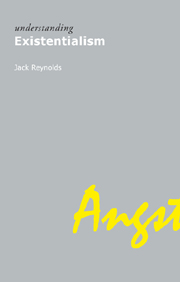Book contents
- Frontmatter
- Contents
- Acknowledgements
- Abbreviations
- 1 Existentialism and its heritage
- 2 Heidegger and the existential analytic
- 3 Condemned to freedom: Sartre's phenomenological ontology
- 4 Sartre: hell is other people
- 5 Merleau-Ponty and the body
- 6 De Beauvoir: feminism and existential ethics
- 7 The legacy of existentialism: deconstruction, responsibility and the time of the decision
- Questions for discussion and revision
- Further reading and references
- Chronology
- Index
3 - Condemned to freedom: Sartre's phenomenological ontology
- Frontmatter
- Contents
- Acknowledgements
- Abbreviations
- 1 Existentialism and its heritage
- 2 Heidegger and the existential analytic
- 3 Condemned to freedom: Sartre's phenomenological ontology
- 4 Sartre: hell is other people
- 5 Merleau-Ponty and the body
- 6 De Beauvoir: feminism and existential ethics
- 7 The legacy of existentialism: deconstruction, responsibility and the time of the decision
- Questions for discussion and revision
- Further reading and references
- Chronology
- Index
Summary
According to several commentators, Jean-Paul Sartre (1905–80) has been read more widely in his own lifetime than any other philosopher in the history of philosophy, and around 100,000 people paid tribute to him at his funeral in Paris. He is also arguably the only self-proclaimed existentialist, at least of the major historical figures associated with the tradition, even if it is true that his initial acceptance of the label consisted largely in a begrudging assent to the media proliferation of the term with which Marcel had first described him and his partner, de Beauvoir. That said, Sartre is rightly considered to be the canonical existentialist, both in terms of public reception (he regularly graced the pages of Vogue in the US in the 1950s and was synonymous with French intellectual life), and academically, where his opus Being and Nothingness: An Essay on Phenomenological Ontology (1943) still stands as the iconic and defining work of the tradition.
Being and Nothingness was partly inspired by Sartre's encounter with Heidegger's Being and Time while he was a prisoner of war. Sartre's main influences in this work are Heidegger, Husserl and Hegel, but it is difficult to determine to what extent each of them influenced him, largely because Sartre's interpretations of them are always creative and do a certain violence to their texts (this is perhaps why Heidegger's response to Sartre in “Letter on Humanism” is so scathing).
- Type
- Chapter
- Information
- Understanding Existentialism , pp. 51 - 88Publisher: Acumen PublishingPrint publication year: 2005



